stop start MITSUBISHI SHOGUN 2008 (in English) Owner's Guide
[x] Cancel search | Manufacturer: MITSUBISHI, Model Year: 2008, Model line: SHOGUN, Model: MITSUBISHI SHOGUN 2008Pages: 538, PDF Size: 25.09 MB
Page 262 of 538
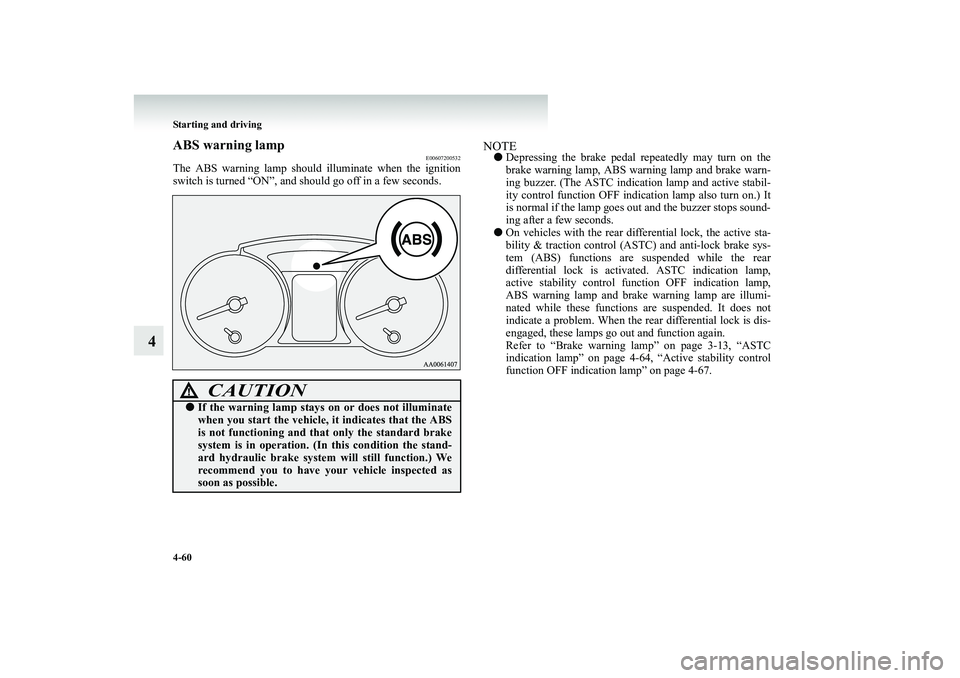
4-60 Starting and driving
4
ABS warning lamp
E00607200532
The ABS warning lamp should illuminate when the ignition switch is turned “ON”, and should go off in a few seconds.
NOTEâ—Ź
Depressing the brake pedal re
peatedly may turn on the
brake warning lamp, ABS warning lamp and brake warn- ing buzzer. (The ASTC indicat
ion lamp and active stabil-
ity control function OFF indication lamp also turn on.) Itis normal if the lamp goes out and the buzzer stops sound- ing after a few seconds.
â—Ź
On vehicles with the rear di
fferential lock, the active sta-
bility & traction control (ASTC) and anti-lock brake sys- tem (ABS) functions are suspended while the rear differential lock is activated. ASTC indication lamp,active stability control function OFF indication lamp, ABS warning lamp and brake warning lamp are illumi- nated while these functions are suspended. It does notindicate a problem. When the r
ear differential lock is dis-
engaged, these lamps go out and function again. Refer to “Brake warning lamp” on page 3-13, “ASTCindication lamp” on page 4-64, “Active stability control function OFF indication lamp” on page 4-67.
CAUTION
!â—Ź
If the warning lamp stays on or does not illuminate when you start the vehicle,
it indicates that the ABS
is not functioning and that
only the standard brake
system is in operation. (I
n this condition the stand-
ard hydraulic brake system will still function.) We recommend you to have your vehicle inspected assoon as possible.
BK-BK2008E1ENUK.en-uk-Section7.fm Page
60 Wednesday, January 9, 2008 4:36 PM
Page 263 of 538
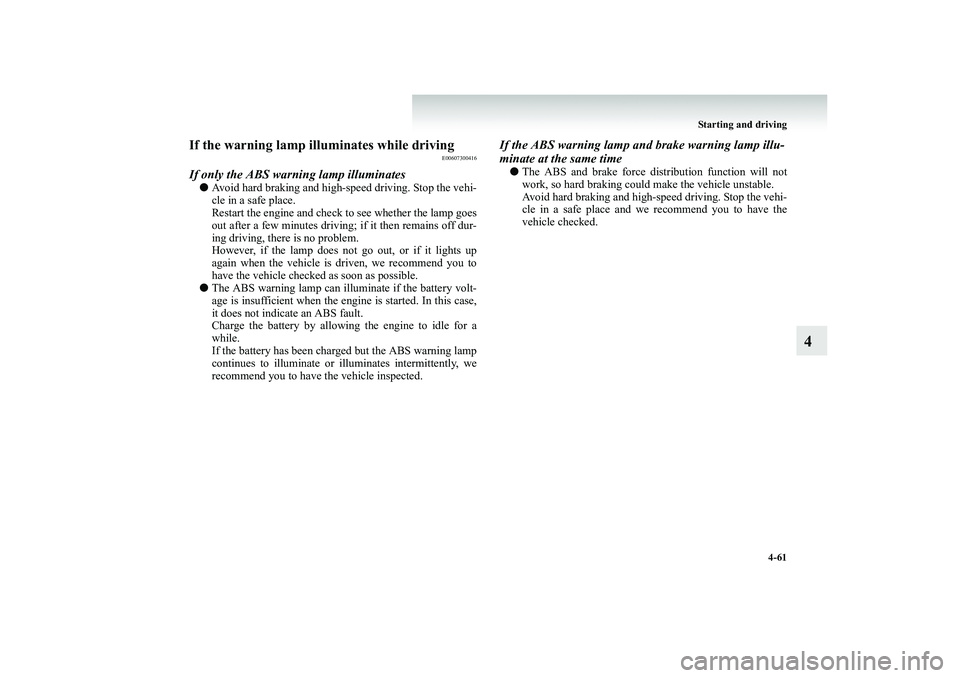
Starting and driving
4-61
4
If the warning lamp illuminates while driving
E00607300416
If only the ABS warning lamp illuminatesâ—Ź
Avoid hard braking and high-speed driving. Stop the vehi- cle in a safe place. Restart the engine and check to see whether the lamp goesout after a few minutes driving; if it then remains off dur- ing driving, there is no problem. However, if the lamp does not go out, or if it lights upagain when the vehicle is driven, we recommend you to have the vehicle checked as soon as possible.
â—Ź
The ABS warning lamp can illuminate if the battery volt- age is insufficient when the en
gine is started. In this case,
it does not indicate an ABS fault. Charge the battery by allowing the engine to idle for awhile. If the battery has been charged but the ABS warning lamp continues to illuminate or illuminates intermittently, werecommend you to have the vehicle inspected.
If the ABS warning lamp and brake warning lamp illu- minate at the same timeâ—Ź
The ABS and brake force distribution function will not work, so hard braking could make the vehicle unstable. Avoid hard braking and high-speed driving. Stop the vehi- cle in a safe place and we recommend you to have thevehicle checked.
BK-BK2008E1ENUK.en-uk-Section7.fm Page
61 Wednesday, January 9, 2008 4:36 PM
Page 265 of 538
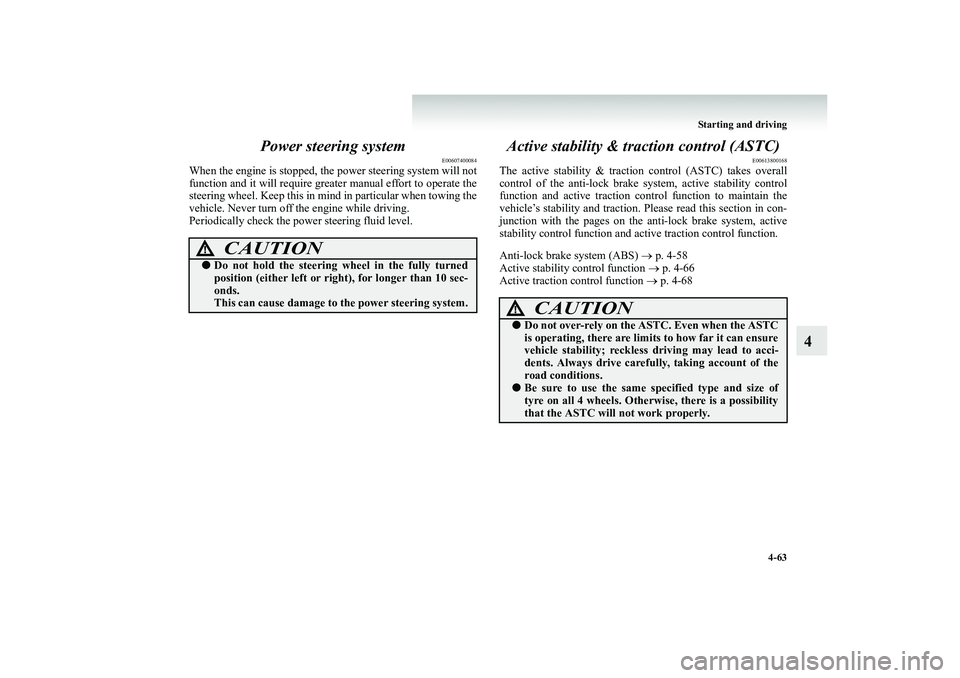
Starting and driving
4-63
4
Power steering system
E00607400084
When the engine is stopped, the
power steering system will not
function and it will require greater
manual effort to operate the
steering wheel. Keep this in mind
in particular when towing the
vehicle. Never turn off the engine while driving. Periodically check the power steering fluid level.
Active stability & traction control (ASTC)
E00613800168
The active stability & traction
control (ASTC) takes overall
control of the anti-lo
ck brake system, active stability control
function and active traction control function to maintain thevehicle’s stability and traction.
Please read this section in con-
junction with the pages on the
anti-lock brake system, active
stability control function and
active traction control function.
Anti-lock brake
system (ABS)
→ p. 4-58
Active stability control function
→ p. 4-66
Active traction control function
→ p. 4-68
CAUTION
!â—Ź
Do not hold the steering
wheel in the fully turned
position (either left or ri
ght), for long
er than 10 sec-
onds.This can cause damage to
the power steering system.
CAUTION
!â—Ź
Do not over-rely on the
ASTC. Even when the ASTC
is operating, there are limits to how far it can ensure vehicle stability; reckless driving may lead to acci-dents. Always drive carefully, taking account of the road conditions.
â—Ź
Be sure to use the same specified type and size of tyre on all 4 wheels. Otherw
ise, there is a possibility
that the ASTC will
not work properly.
BK-BK2008E1ENUK.en-uk-Section7.fm Page
63 Wednesday, January 9, 2008 4:36 PM
Page 268 of 538
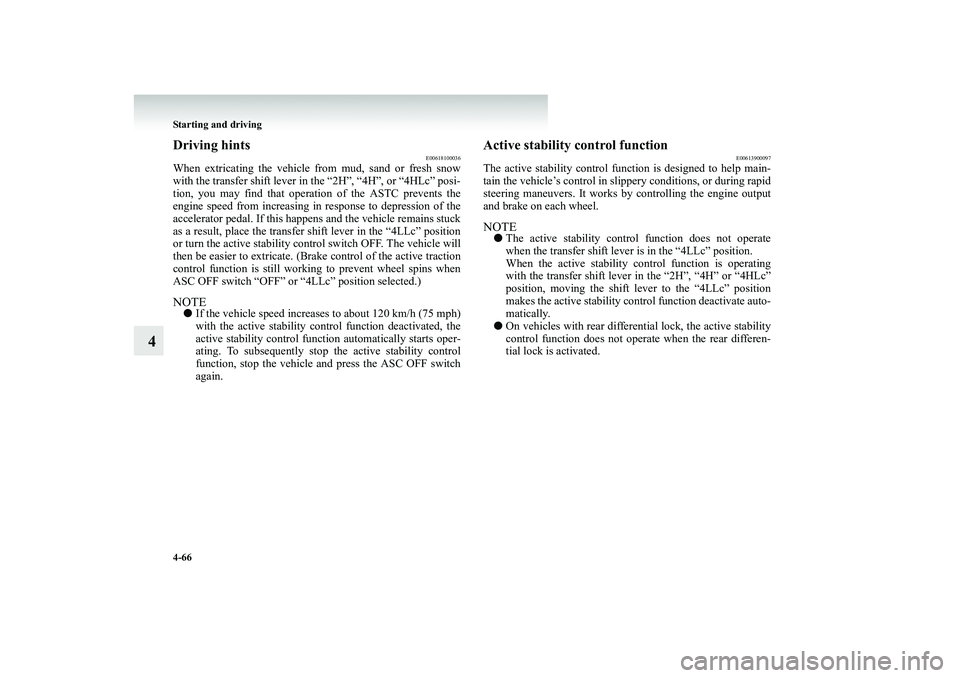
4-66 Starting and driving
4
Driving hints
E00618100036
When extricating the vehicle
from mud, sand or fresh snow
with the transfer shift lever in the “2H”, “4H”, or “4HLc” posi- tion, you may find that operation of the ASTC prevents the engine speed from increasing in
response to depression of the
accelerator pedal. If this happens
and the vehicle remains stuck
as a result, place the transfer sh
ift lever in the “4LLc” position
or turn the active stability cont
rol switch OFF. The vehicle will
then be easier to extricate. (Bra
ke control of the active traction
control function is still working to prevent wheel spins when ASC OFF switch “OFF” or
“4LLc” position selected.)
NOTEâ—Ź
If the vehicle speed increases
to about 120 km/h (75 mph)
with the active stability cont
rol function deactivated, the
active stability control function automatically starts oper-ating. To subsequently stop the active stability control function, stop the vehicle
and press the ASC OFF switch
again.
Active stability control function
E00613900097
The active stability control function is designed to help main-tain the vehicle’s control in slippery conditions, or during rapid steering maneuvers. It works by controlling the engine output and brake on each wheel.NOTE●
The active stability control function does not operate when the transfer shift lever is in the “4LLc” position. When the active stability control function is operatingwith the transfer shift lever
in the “2H”, “4H” or “4HLc”
position, moving the shift lever to the “4LLc” position makes the active stability cont
rol function d
eactivate auto-
matically.
â—Ź
On vehicles with rear differ
ential lock, th
e active stability
control function does not operate when the rear differen-tial lock is activated.
BK-BK2008E1ENUK.en-uk-Section7.fm Page
66 Wednesday, January 9, 2008 4:36 PM
Page 269 of 538
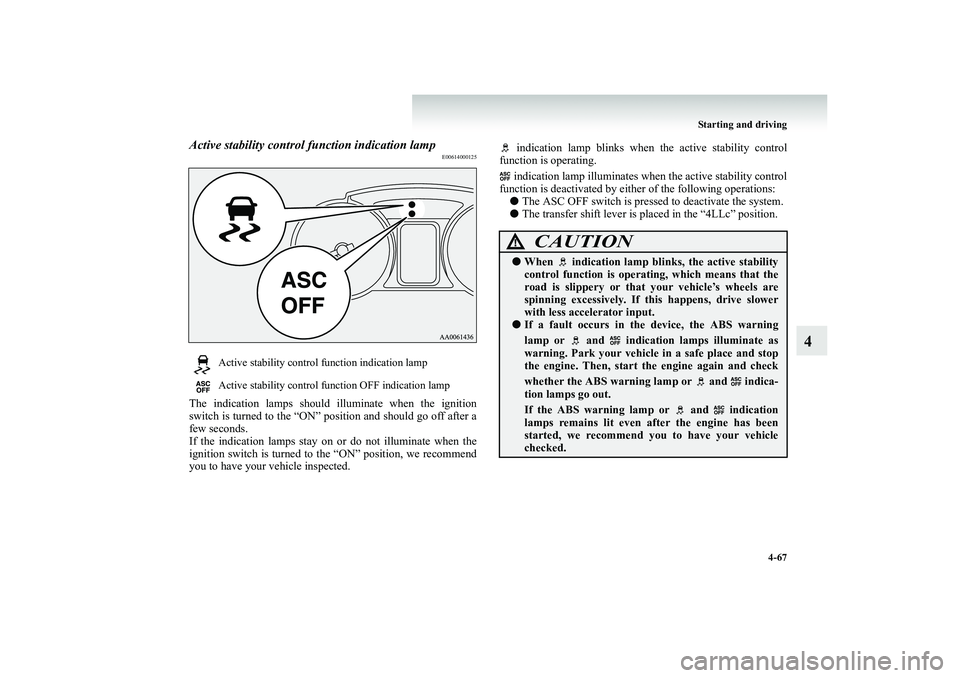
Starting and driving
4-67
4
Active stability control function indication lamp
E00614000125
The indication lamps should illuminate when the ignition switch is turned to the “ON” position and should go off after a few seconds.If the indication lamps stay on or do not illuminate when the ignition switch is turned to the “ON” position, we recommend you to have your vehicle inspected.
indication lamp blinks when
the active stability control
function is operating.
indication lamp illuminates when the active stability control
function is deactivated by either of the following operations: â—Ź
The ASC OFF switch is presse
d to deactivate the system.
â—Ź
The transfer shift lever is
placed in the “4LLc” position.
Active stability control function indication lamp Active stability control function OFF indication lamp
CAUTION
!â—Ź
When indication lamp bl
inks, the active stability
control function is operating, which means that the road is slippery or that
your vehicle’s wheels are
spinning excessively. If this happens, drive slower with less accelerator input.
â—Ź
If a fault occurs in th
e device, the ABS warning
lamp or and indication lamps illuminate as warning. Park your vehicl
e in a safe place and stop
the engine. Then, start the engine again and check whether the ABS warning la
mp or and indica-
tion lamps go out. If the ABS warning lamp or and indication lamps remains lit even af
ter the engine has been
started, we recommend you to have your vehicle checked.
BK-BK2008E1ENUK.en-uk-Section7.fm Page
67 Wednesday, January 9, 2008 4:36 PM
Page 270 of 538
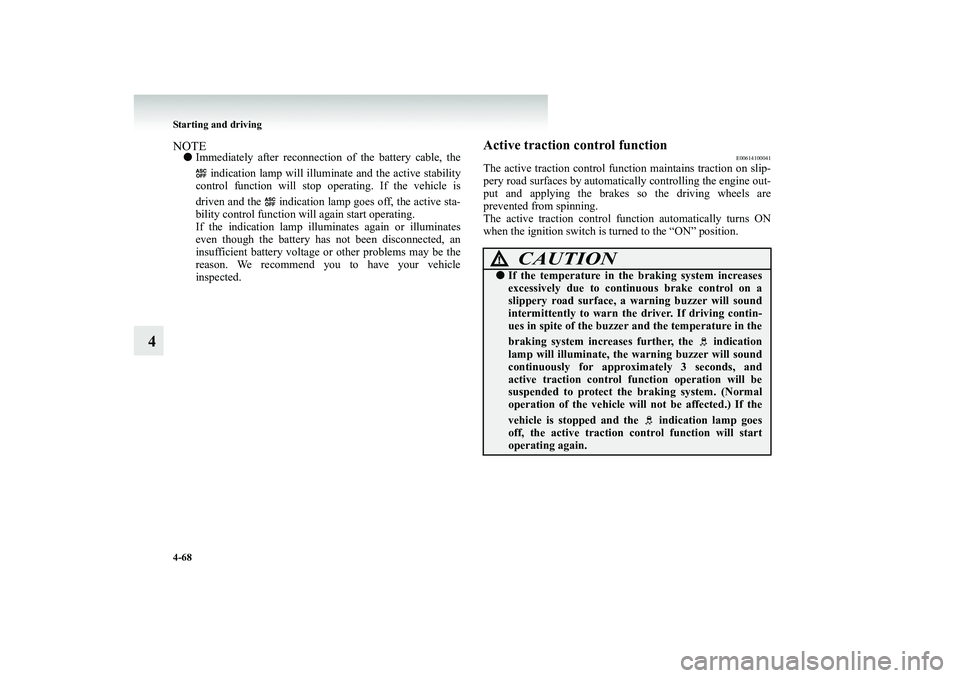
4-68 Starting and driving
4
NOTEâ—Ź
Immediately after reconnecti
on of the battery cable, the
indication lamp will illuminate and the active stability
control function will stop operating. If the vehicle is driven and the indication la
mp goes off, the active sta-
bility control function will again start operating. If the indication lamp illuminates again or illuminates even though the battery has not been disconnected, aninsufficient battery voltage or other problems may be the reason. We recommend you to have your vehicle inspected.
Active traction control function
E00614100041
The active traction control function maintains traction on slip-pery road surfaces by automatical
ly controlling the engine out-
put and applying the brakes
so the driving wheels are
prevented from spinning.The active traction control f
unction automatically turns ON
when the ignition switch is turned to the “ON” position.
CAUTION
!â—Ź
If the temperature in the
braking system increases
excessively due to conti
nuous brake control on a
slippery road surface,
a warning buzzer will sound
intermittently to warn the
driver. If driving contin-
ues in spite of the buzzer an
d the temperature in the
braking system increases
further, the indication
lamp will illuminate, th
e warning buzzer will sound
continuously for approx
imately 3 seconds, and
active traction control function operation will besuspended to protect the
braking system. (Normal
operation of the ve
hicle will not be
affected.) If the
vehicle is stopped and the indication lamp goes off, the active traction control function will start operating again.
BK-BK2008E1ENUK.en-uk-Section7.fm Page
68 Wednesday, January 9, 2008 4:36 PM
Page 282 of 538
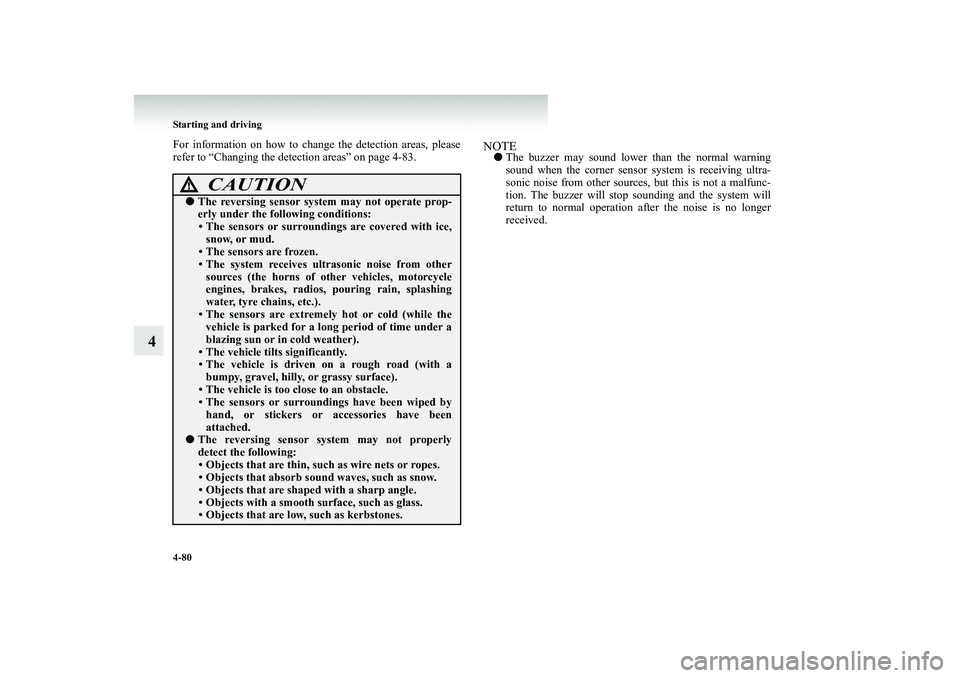
4-80 Starting and driving
4
For information on how to chan
ge the detection areas, please
refer to “Changing the detection areas” on page 4-83.
NOTEâ—Ź
The buzzer may sound lower
than the normal warning
sound when the corner sensor
system is receiving ultra-
sonic noise from other sources, but this is not a malfunc- tion. The buzzer will stop sounding and the system willreturn to normal operation after the noise is no longer received.
CAUTION
!â—Ź
The reversing sensor system may not operate prop- erly under the following conditions:• The sensors or surroundings are covered with ice,snow, or mud.• The sensors are frozen.• The system receives ultrasonic noise from othersources (the horns of ot
her vehicles, motorcycle
engines, brakes, radios,
pouring rain, splashing
water, tyre chains, etc.).• The sensors are extremely hot or cold (while the vehicle is parked for a lo
ng period of time under a
blazing sun or in cold weather).• The vehicle tilts significantly.• The vehicle is driven on a rough road (with abumpy, gravel, hilly, or grassy surface).• The vehicle is too close to an obstacle.• The sensors or surroundings have been wiped byhand, or stickers or accessories have been attached.
â—Ź
The reversing sensor system may not properly detect the following:• Objects that are thin, such as wire nets or ropes.• Objects that absorb sound waves, such as snow.• Objects that are shaped
with a sharp angle.
• Objects with a smooth su
rface, such as glass.
• Objects that are low, such as kerbstones.
BK-BK2008E1ENUK.en-uk-Section7.fm Page
80 Wednesday, January 9, 2008 4:36 PM
Page 283 of 538
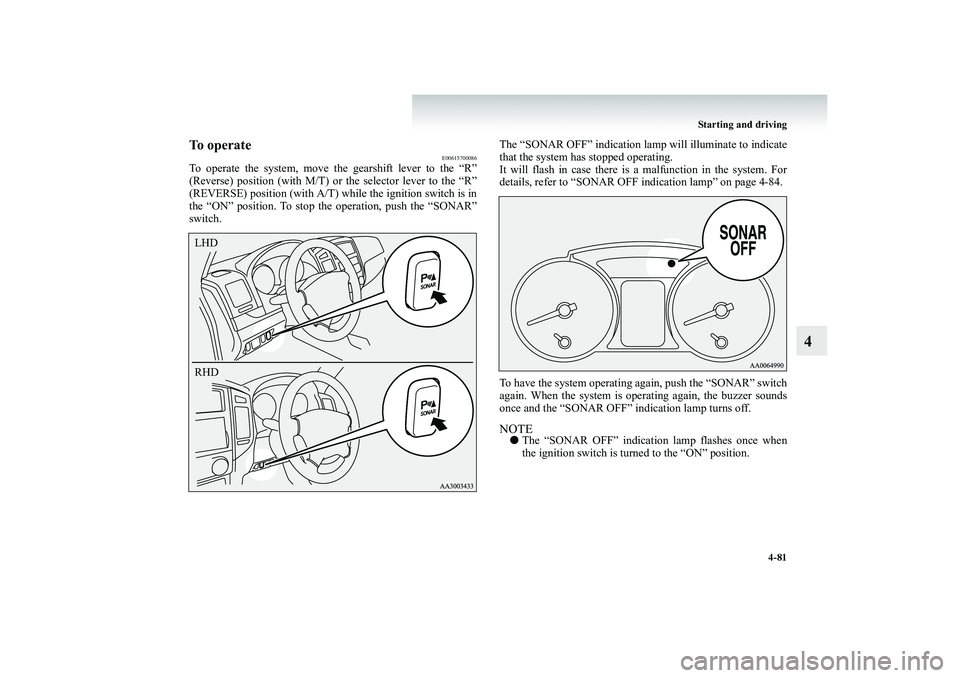
Starting and driving
4-81
4
To operate
E00615700086
To operate the system, move th
e gearshift lever to the “R”
(Reverse) position (with M/T) or the selector lever to the “R” (REVERSE) position (with A/T) while the ignition switch is in the “ON” position. To stop th
e operation, push the “SONAR”
switch.
The “SONAR OFF” indication lamp will illuminate to indicate that the system has stopped operating. It will flash in case there is a malfunction in the system. For details, refer to “SONAR OFF indication lamp” on page 4-84. To have the system operating
again, push the “SONAR” switch
again. When the system is op
erating again, the buzzer sounds
once and the “SONAR OFF”
indication lamp turns off.
NOTEâ—Ź
The “SONAR OFF” indicati
on lamp flashes once when
the ignition switch is turned to the “ON” position.
LHD RHD
BK-BK2008E1ENUK.en-uk-Section7.fm Page
81 Wednesday, January 9, 2008 4:36 PM
Page 284 of 538
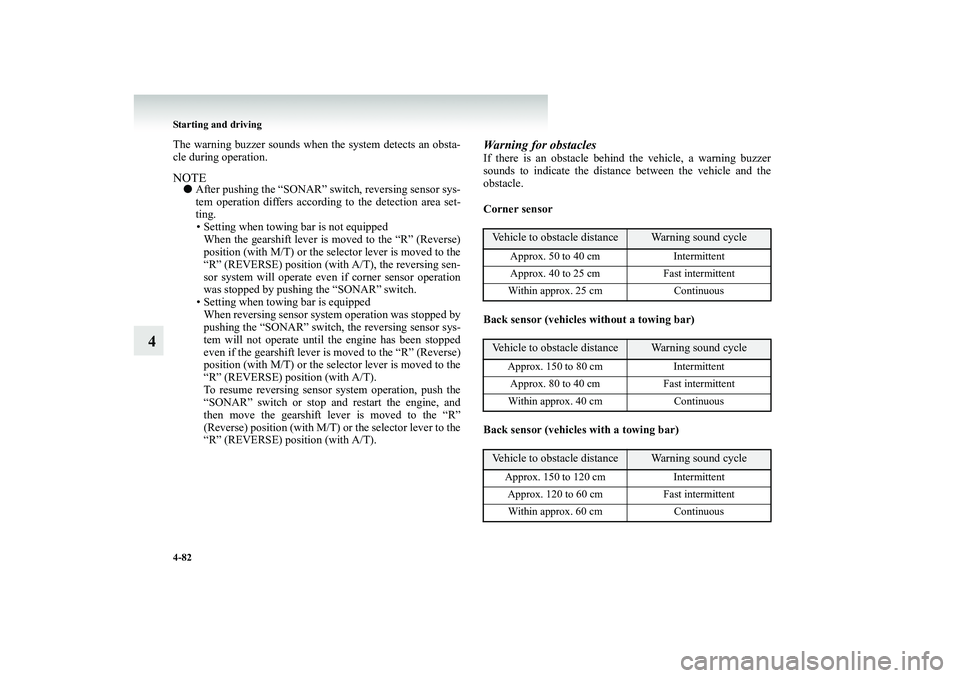
4-82 Starting and driving
4
The warning buzzer sounds when the system detects an obsta- cle during operation.NOTEâ—Ź
After pushing the “SONAR” switch, reversing sensor sys- tem operation differs accordi
ng to the detection area set-
ting. • Setting when towing bar is not equipped When the gearshift lever is
moved to the “R” (Reverse)
position (with M/T) or the selector lever is moved to the “R” (REVERSE) position (with A/T), the reversing sen- sor system will operate even
if corner sensor operation
was stopped by pushing the “SONAR” switch. • Setting when towing bar is equipped When reversing sensor system operation was stopped bypushing the “SONAR” switch, the reversing sensor sys- tem will not operate until the engine has been stopped even if the gearshift lever is moved to the “R” (Reverse)position (with M/T) or the selector lever is moved to the “R” (REVERSE) position (with A/T). To resume reversing sensor system operation, push the“SONAR” switch or stop and restart the engine, and then move the gearshift lever is moved to the “R” (Reverse) position (with M/T) or the selector lever to the“R” (REVERSE) position (with A/T).
Warning for obstaclesIf there is an obstacle behind
the vehicle, a warning buzzer
sounds to indicate the distance between the vehicle and the obstacle. Corner sensor
Back sensor (vehicles without a towing bar)
Back sensor (vehicles with a towing bar)
Vehicle to obstacle distance
Warning sound cycle
Approx. 50 to 40 cm Intermittent Approx. 40 to 25 cm Fast intermittent Within approx. 25 cm Continuous
Vehicle to obstacle distance
Warning sound cycle
Approx. 150 to 80 cm Intermittent Approx. 80 to 40 cm Fast intermittentWithin approx. 40 cm Continuous
Vehicle to obstacle distance
Warning sound cycle
Approx. 150 to 120 cm IntermittentApprox. 120 to 60 cm Fast intermittentWithin approx. 60 cm Continuous
BK-BK2008E1ENUK.en-uk-Section7.fm Page
82 Wednesday, January 9, 2008 4:36 PM
Page 285 of 538
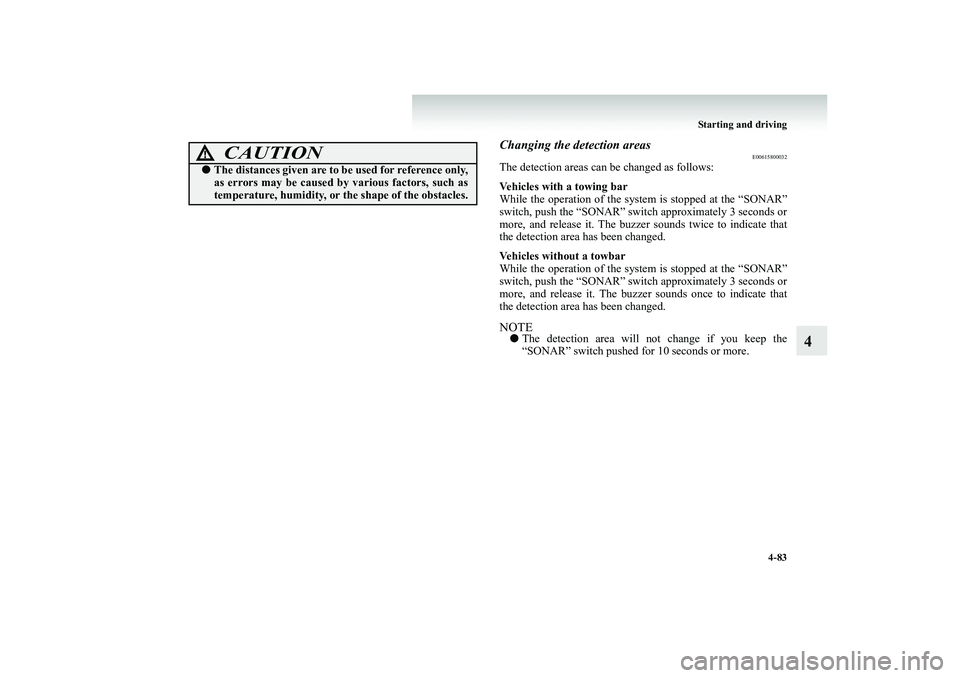
Starting and driving
4-83
4
Changing the detection areas
E00615800032
The detection areas can be changed as follows: Vehicles with a towing bar While the operation of the system
is stopped at the “SONAR”
switch, push the “SONAR” switch approximately 3 seconds or more, and release it. The buzzer
sounds twice to indicate that
the detection area has been changed. Vehicles without a towbar While the operation of the system
is stopped at the “SONAR”
switch, push the “SONAR” switch approximately 3 seconds ormore, and release it. The buzzer
sounds once to indicate that
the detection area has been changed.NOTEâ—Ź
The detection area will not
change if you keep the
“SONAR” switch pushed fo
r 10 seconds or more.
CAUTION
!â—Ź
The distances given are to be used for reference only, as errors may be caused by various factors, such astemperature, humidity, or the shape of the obstacles.
BK-BK2008E1ENUK.en-uk-Section7.fm Page
83 Wednesday, January 9, 2008 4:36 PM